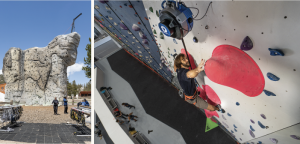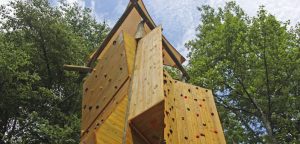Today, more than 600 indoor climbing gyms in the United States draw serious climbers looking to train, as well as those looking for a more social experience. At the same time, outdoor climbing walls have become commonplace at youth camps, university campuses, and can be found at some—but not many—ski areas and adventure parks, where they offer one more draw for active guests.
With all the growth the sport of climbing has seen, it might seem logical for more adventure parks to offer climbing walls among their activities. Yet, outdoor climbing-specific walls have not gained as strong of a foothold at smaller adventure parks as they have at youth camps, nor have they grown in popularity as quickly as indoor climbing gyms. Aside from some of the larger adventure parks and ski areas looking to expand summer operations, many aerial adventure parks haven’t even installed traditional outdoor climbing walls.
“I have not experienced much climbing incorporated within traditional commercial adventure parks,” confirms Michael Johnson, COO of Signature Research, a design and build company for adventure parks and challenge courses. “Most of the time when we see climbing, it’s either within a total program, like a camp or a university, or it’s indoors for something like a YMCA or climbing gym.”
Indoor Climbing a Hindrance?
It may seem odd that there isn’t a higher demand for climbing at pay-to-play adventure parks. With the release of the Oscar-winning film “Free Solo” in 2018, and the sport’s debut appearance in the 2020 Summer Olympics, you’d be hard-pressed to find someone unaware of climbing.
The fact that indoor climbing gyms have been popping up in towns nationwide, says Andrew Miller, vice president of park designer and builder Challenge Towers, could explain the lack of interest in climbing walls among adventure park operators.
“Climbing gyms are so prevalent now that it’s no longer a unique thing,” says Miller. “Most kids have probably been to a climbing gym. The climbing gym industry is so strong at this point that I think people are scratching that itch at facilities built specifically for [climbing].”

Left: Simulated rock climbing wall at Heavenly Mountain Resort, Calif. Right: Stratton Mountain Resort, Vt., transformed an underutilized indoor space into CLIMB • Stratton Rocks and Boulders, the area’s new climbing gym. Eldorado Climbing Walls was tapped to create a dedicated space for bouldering and roped climbing
An Easy Add-On
But this doesn’t mean that climbing, in some form, has no place in aerial adventure parks. There are several ski areas, such as Mammoth Mountain and Heavenly Mountain Resort, Calif., and Snowmass, Colo., that have incorporated outdoor walls into summer operations. A number of larger adventure parks, such as the Whitewater Center in North Carolina, also offer an outdoor climbing wall experience. But at Whitewater, the climbing itself is a draw—the Center offers single-activity day passes that allow access to the nearly 100 bouldering and top-rope routes and a 46-foot-tall sport climbing tower for $25, or a single activity pass allowing access to deep water soloing walls for $35. An all-access day pass for all activities is also offered, which includes climbing, rafting, mountain biking, and ropes courses, among other attractions.
Although climbing walls might not be as significant a draw as zip lines and ropes courses at smaller aerial adventure parks, the potential exists for expanding a park’s business. And there are several low-cost ways to incorporate walls into an aerial adventure site. Climbing towers can double as zip line platforms, free fall towers or entry points for ropes courses. They can also keep guests entertained while they wait for their zip tour or challenge course trek to start and can serve younger family members who may not meet the height and weight requirements of adult-sized zip lines and challenge courses.
“Climbing in the grand scheme of things is very cost-effective, because it’s super low maintenance,” says Christina Frain, director of marketing for Colorado-based Eldorado Climbing Walls, which sells custom and modular climbing walls, among other products. “You don’t need to have super high staffing ratios to do it, and you have high throughput. All these things are beneficial to [adventure parks]looking to have another activity.”
Parks that are considering adding climbing elements have plenty of options to choose from. For example, Eldorado Climbing Walls offers a variety of stand-alone climbing-specific walls, from small “boulders” to massive, high-capacity walls. Challenge Towers offers a multi-purpose climbing tower, dubbed the “Watch Tower Series,” which boasts 1,600 square feet of climbing and rappelling surface, a roofed observation deck that can double as a zip line or access platform, and an internal staircase. Walltopia and many industry vendors also offer a range of wall options.
Understanding Costs
Typically, stand-alone climbing walls can cost as little as $125,000 for a two-pole, single-face outdoor wall, and rise to as much as $1.5 million for something like a 12-face faux rock wall with a concrete foundation. Used portable walls can sometimes be found for as little as around $6,000, although auto-belay systems and cables will likely have to be replaced, or at the very least, serviced. While you might get lucky while searching for a deal, used outdoor walls starting at around 24 feet more commonly are found between $15,000 to $30,000. A new Watch Tower ranges from $175,000 to $350,000, depending on specifications and site preparation.
Aside from the up-front cost of installing the structure, auto-belay systems, which are commonly used due to their lower staffing and training requirements, must be serviced annually, at a few hundred dollars each. According to Frain, plastic hand holds used on outdoor walls do need to be replaced eventually, although they typically last several years. And periodically removing and pressure washing the holds can also be beneficial, resulting in a better experience for guests climbing the walls. Otherwise, the walls themselves don’t require much maintenance. To keep guests excited and wanting to come back to climb, it’s recommended that operators move the holds around occasionally to change up the routes.
Ski Areas and Outdoor Climbing
Ski area summer operations demonstrate the potential for climbing walls at adventure parks. For winter resorts looking for ways to create revenue during the off-season, climbing walls seamlessly fit into the mix for visitors looking for an adventure-fueled outdoor experience.
At Lost Forest adventure park, located mid-mountain at Snowmass, Colo., three to four employees staff the 14-route outdoor climbing wall on busy days. The wall was built by Eldorado in 2017 and opened in 2018, along with most of The Lost Forest, which includes aerial trekking courses, a zip tour, and a mountain coaster, among other activities. Resort staff say the wall complements these other activities well.
“[Climbing] is something that pretty much anybody can do,” says Snowmass director of guest services Dave Gray. “The main draw [at Snowmass]is probably the coaster, but people will spend some time there, and with us packaging the activities together, will then spend a few hours at the climbing wall. I think it definitely helps to have this as another draw.”
Like Snowmass, Heavenly has also had success with its outdoor climbing wall, which was also built by Eldorado and has been in operation at its adventure park since 2016. According to Stephen Greig, the senior manager at the Adventure Center at Heavenly, the climbing wall has been very popular, and he expects that trend to continue. Guests can purchase a $27 ticket to the climbing wall separately at the ticket window, or as part of a package with other activities for $58.
And for those really thinking about the future and the shorter winters ski areas worldwide will likely face, installing a south-facing stone or concrete wall could allow them to extend the off-season even further, offering a bubble of warmth for guests as days get shorter.
An added benefit for ski areas that have installed or are considering installing a climbing wall is that it can help retain employees year-round, making staffing less of a headache when the snow flies.
The Evolution of Artificial Walls
At Heavenly, the 25-foot-tall, man-made rock wall was designed to blend seamlessly with the natural landscape. Plastic handholds, which can be moved around to change the difficulty of routes, are utilized in addition to natural, realistic features.
Walls like the one at Heavenly have come a long way from the artificial outdoor climbing structures of the 1980s and ‘90s, which were often not much more than a structure made with a pressure-treated wood utility pole with blocks of wood or molded polyester or polyurethane as hand holds.
While simple structures supported by wood poles are still in use, many operators have replaced the wooden blocks of the past with molded plastic hand and foot holds. Today, many walls also use grid systems with steel substructures used to support panels made of some sort of composite material—molded plastic, fiberglass, or, like the walls at Snowmass and Heavenly, faux rock.
Walls at indoor climbing-specific gyms have evolved differently from outdoor walls, with an endless variety of complex, tall, overhanging routes on composite panels that are often changed weekly or monthly.
Realistic walls made of faux rock, many with just a handful of routes, are becoming more commonplace in the outdoors, especially at operations within forest service land, where stringent regulations often require structures and activities to blend in with the landscape.
At camps and indoor climbing gyms, top-rope systems are often used, in which a second person belays the climber, creating an interactive and educational experience. At ski areas and adventure parks, however, it’s much more common to use auto-belay systems, which are less staff-intensive and allow users to climb without a partner.
As with the walls themselves, auto-belay systems are making leaps and bounds in technological advancements. Head Rush Technologies’ TRUBLUE auto-belays are one of the more widely used systems, and utilize magnetic braking technology, minimizing the amount of moving parts and resulting maintenance. Recently, Head Rush released the TRUBLUE iQ+, which has a “catch and hold” option, where climbers can press a button before climbing that causes the auto-belay to pause for 15 or 20 seconds before lowering, giving climbers the opportunity to try again from the point they fell off.
Potential for Parks
Although outdoor climbing walls have not become as popular at aerial adventure parks as some other activities, despite the technological advancements in wall design and belay systems, one thing is for certain—the sport of climbing isn’t going away. Those who take a chance on it will have one more adventure-fueled activity that anyone can try.







